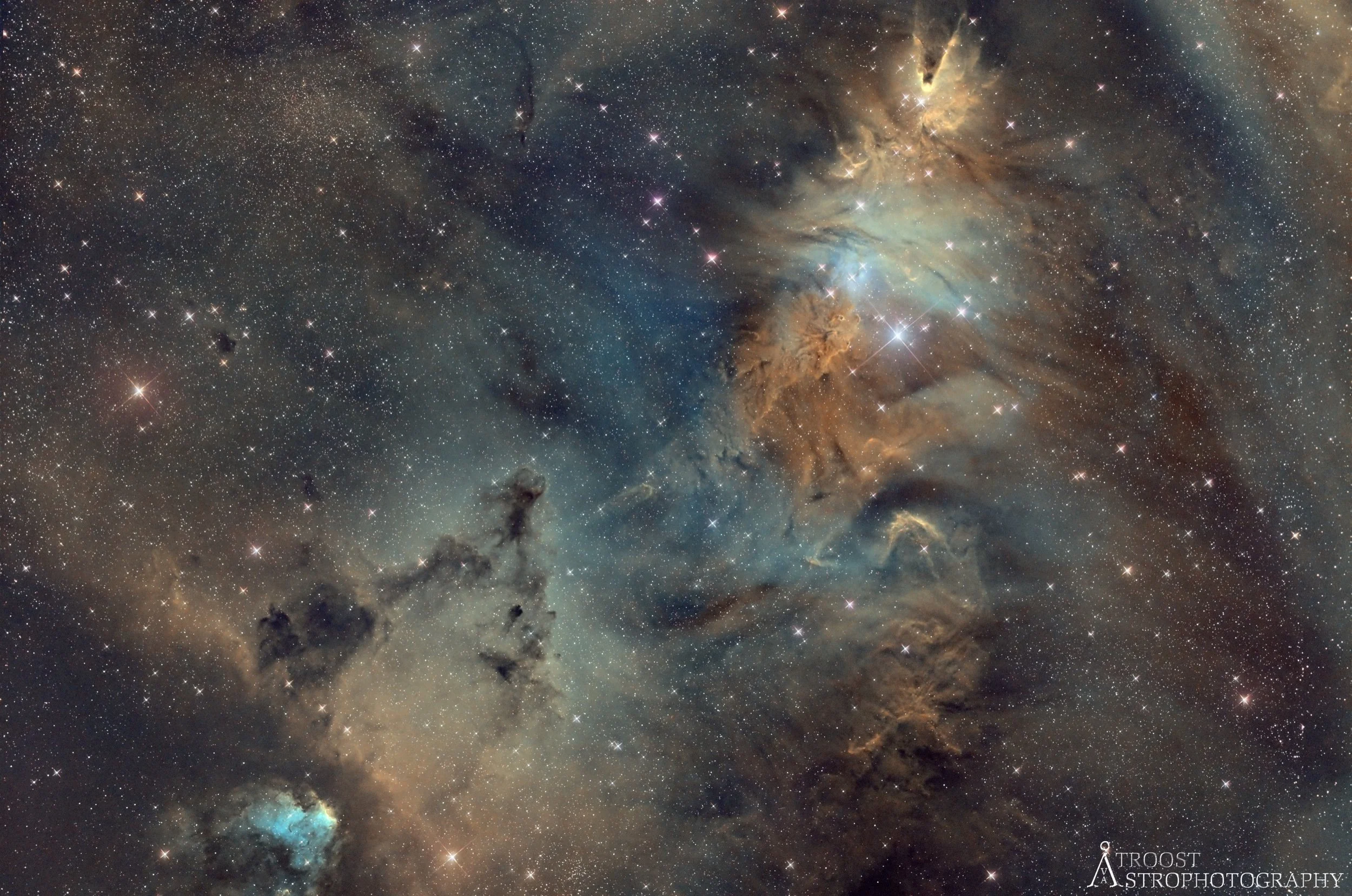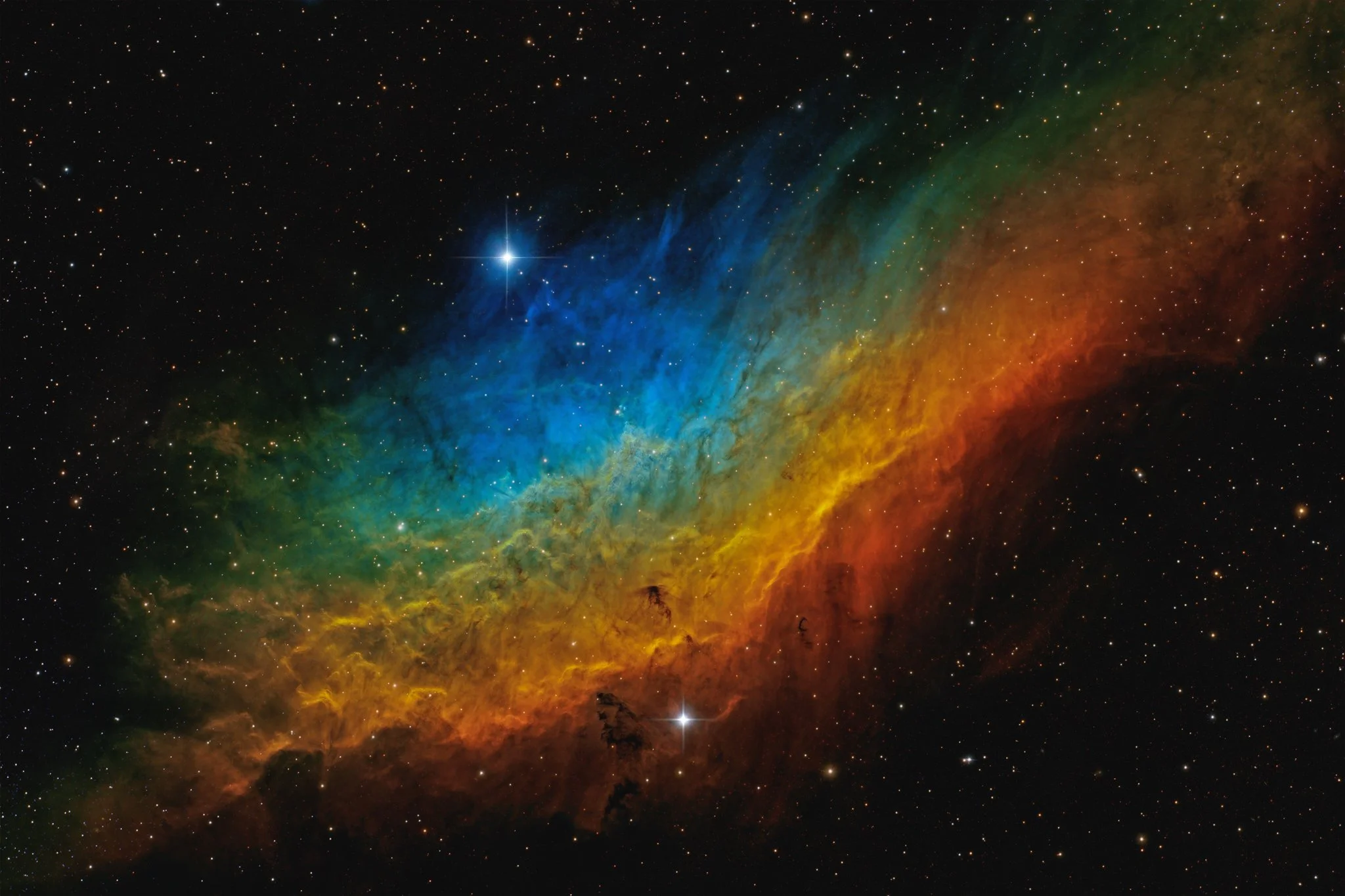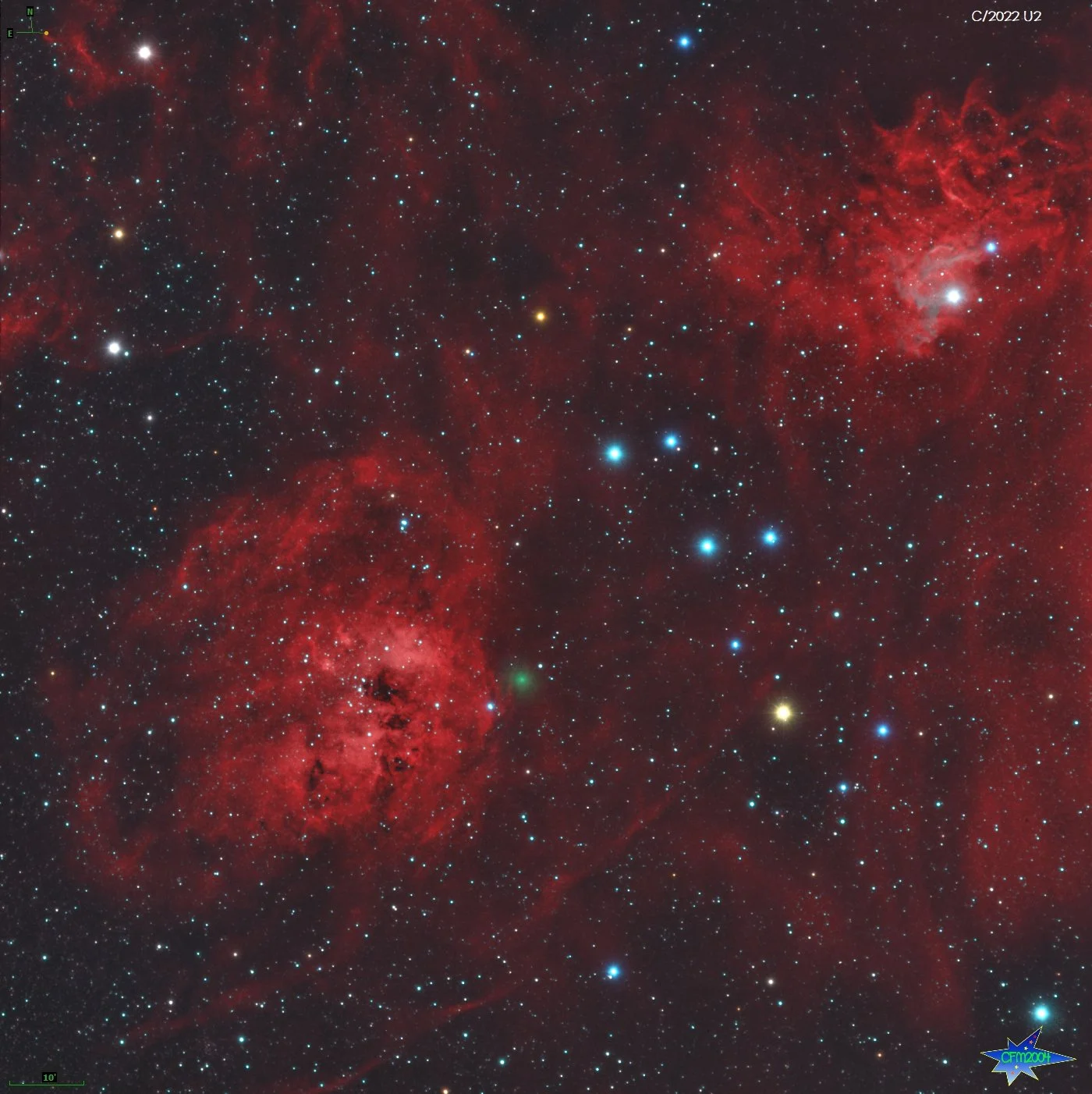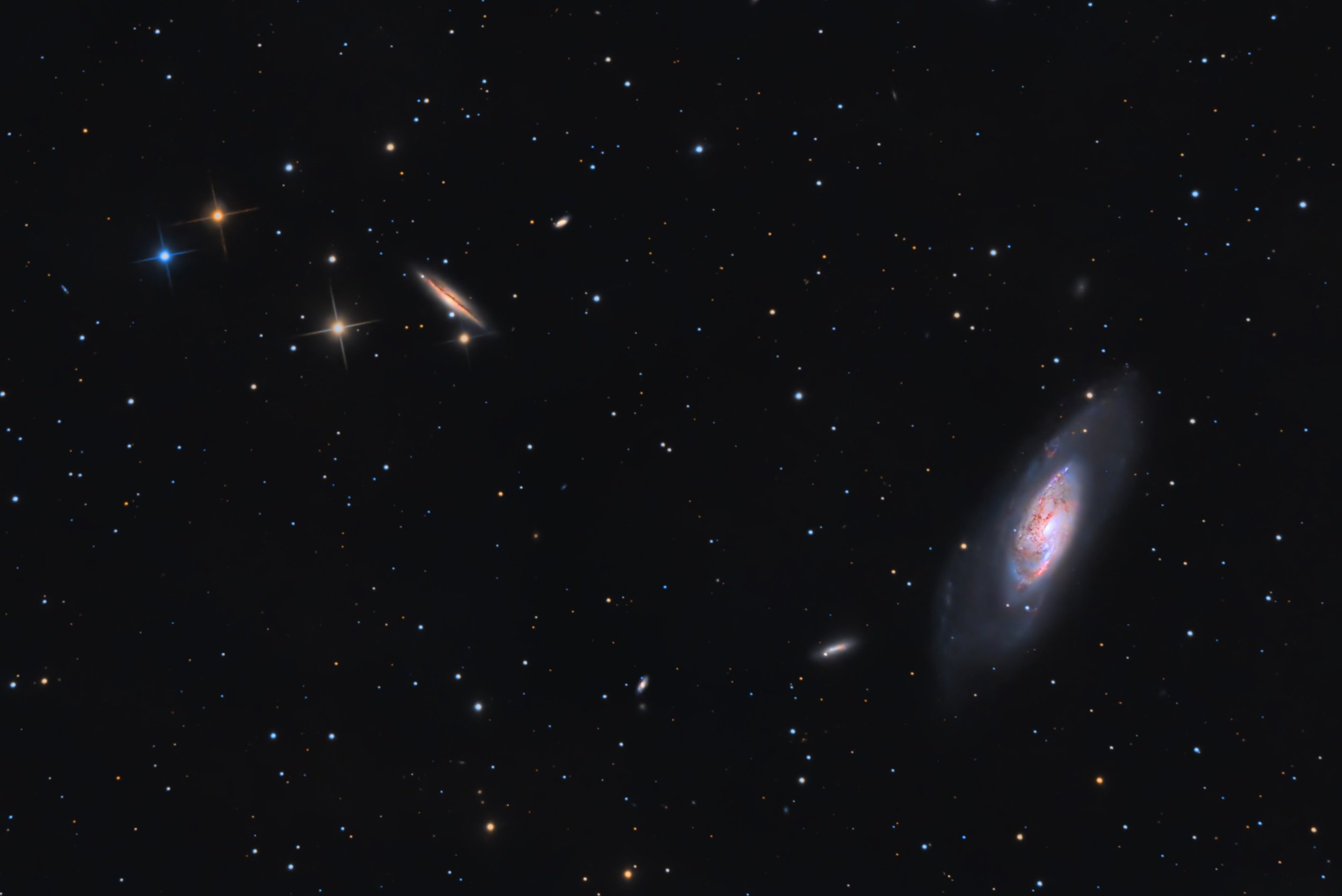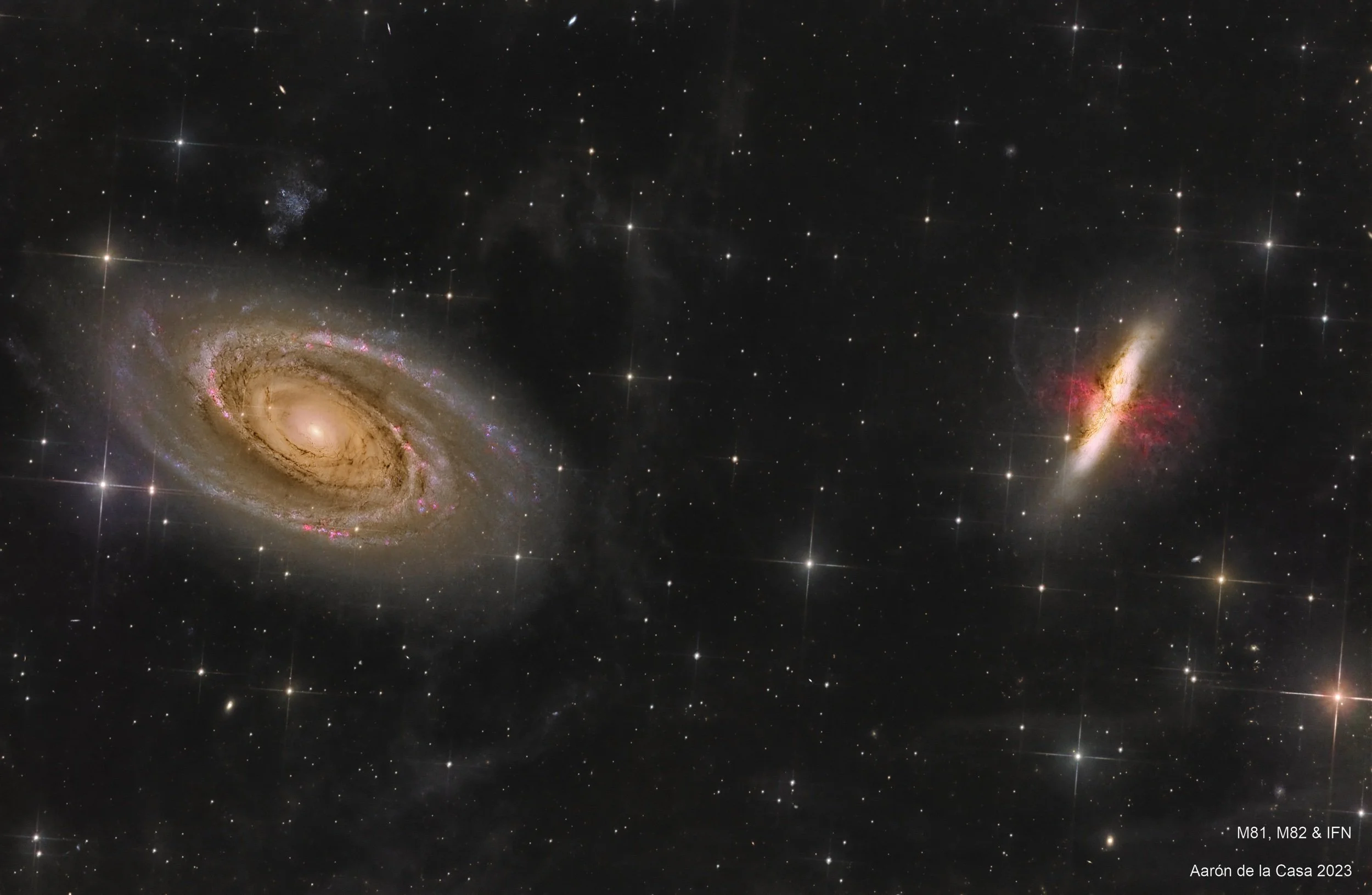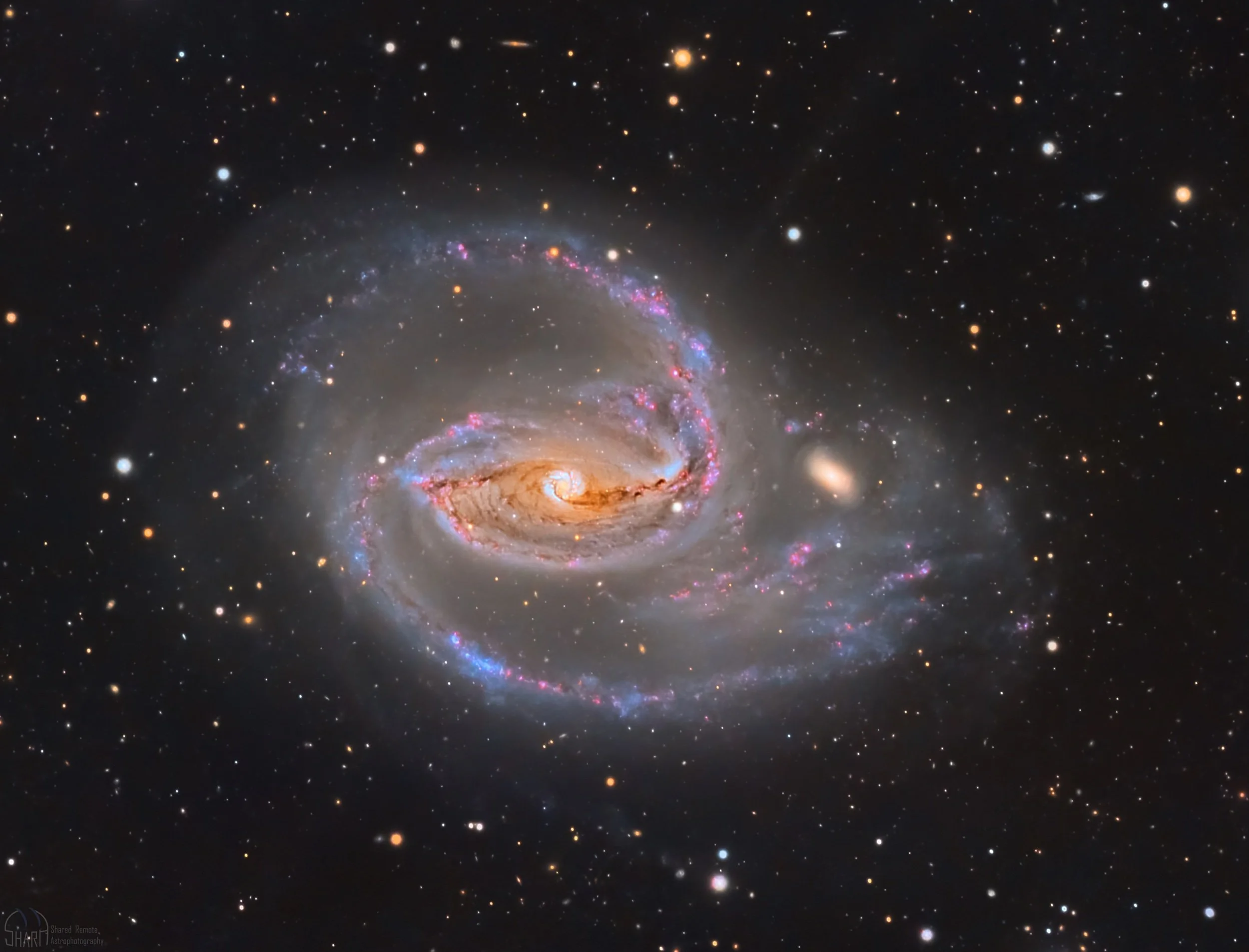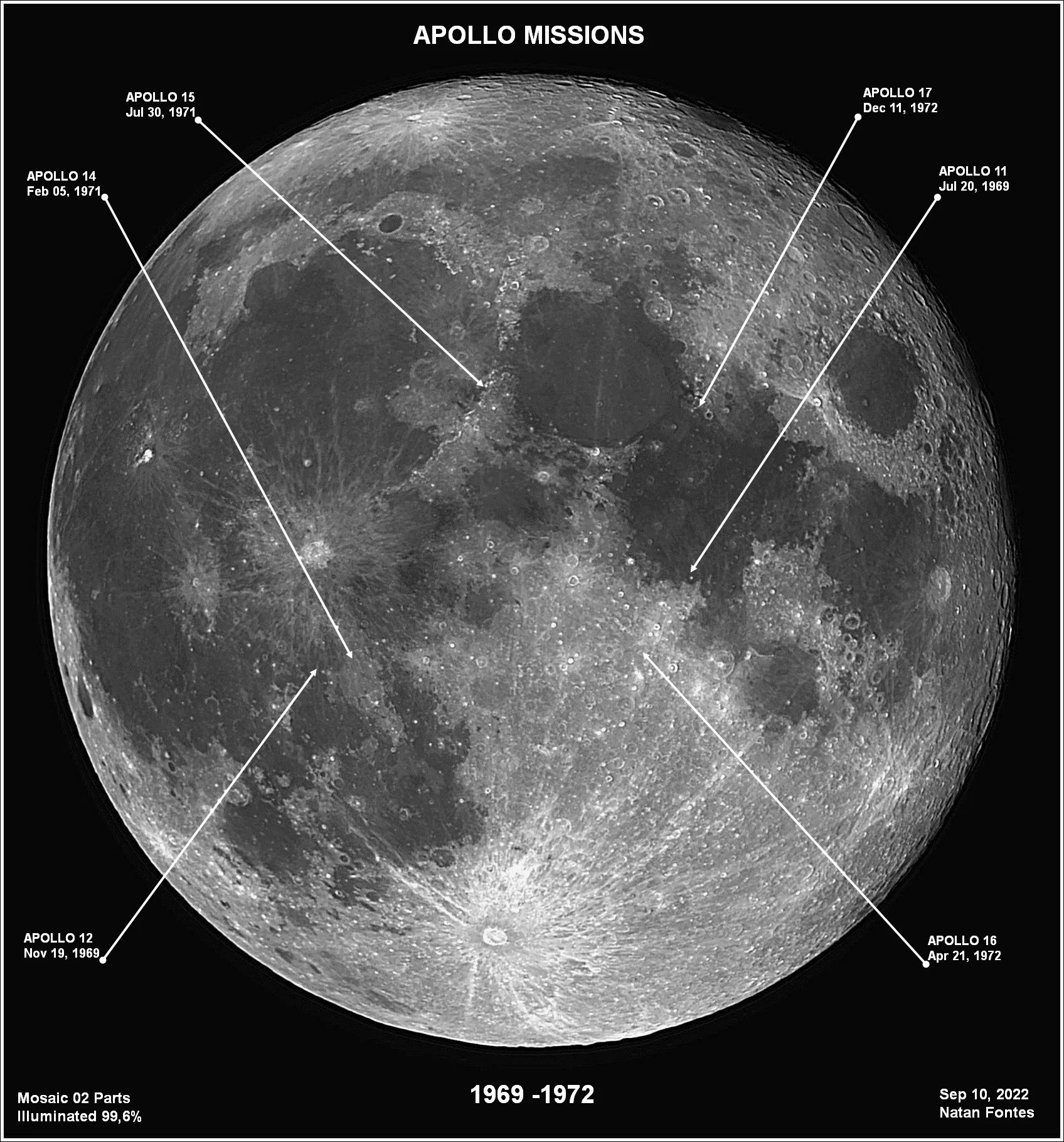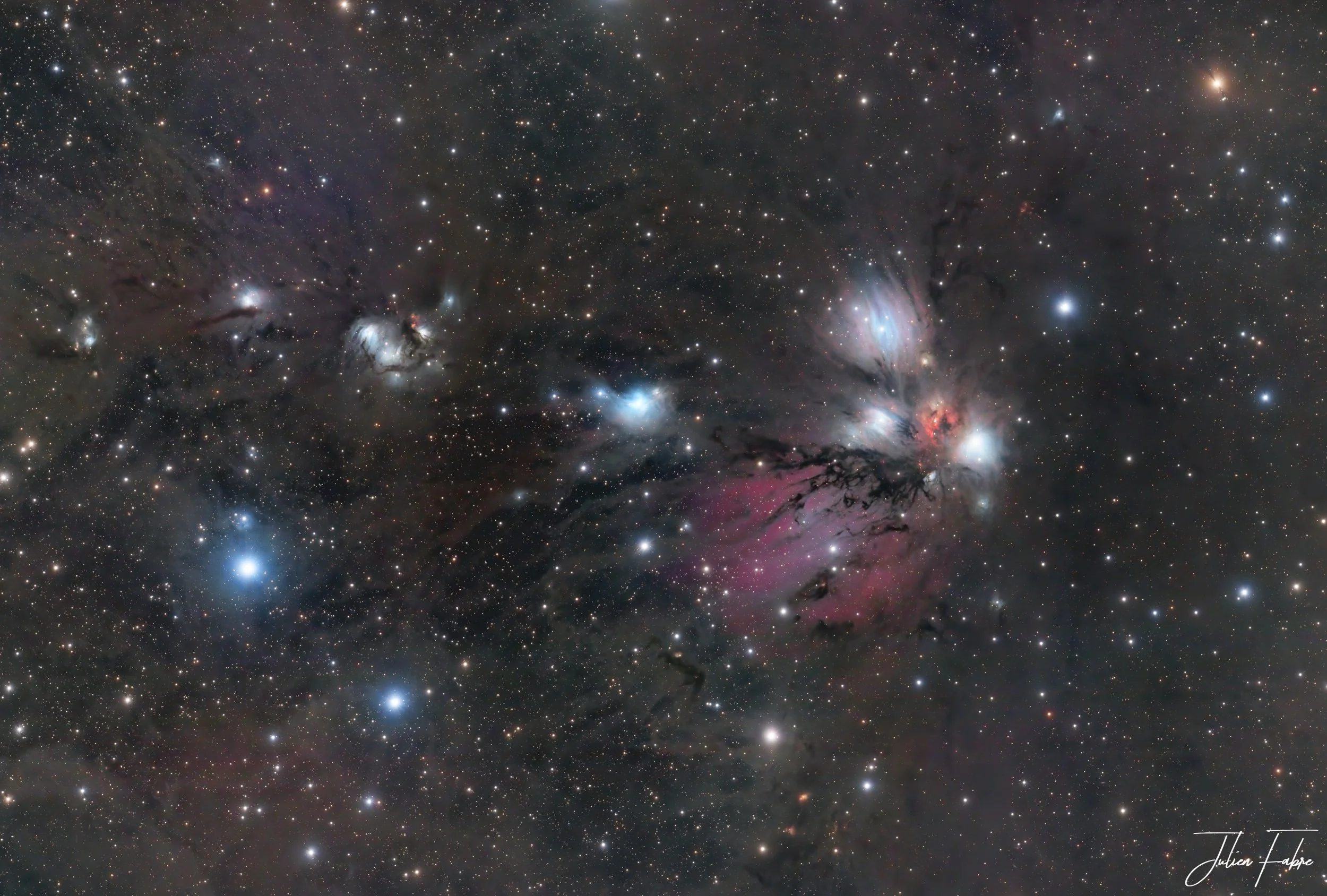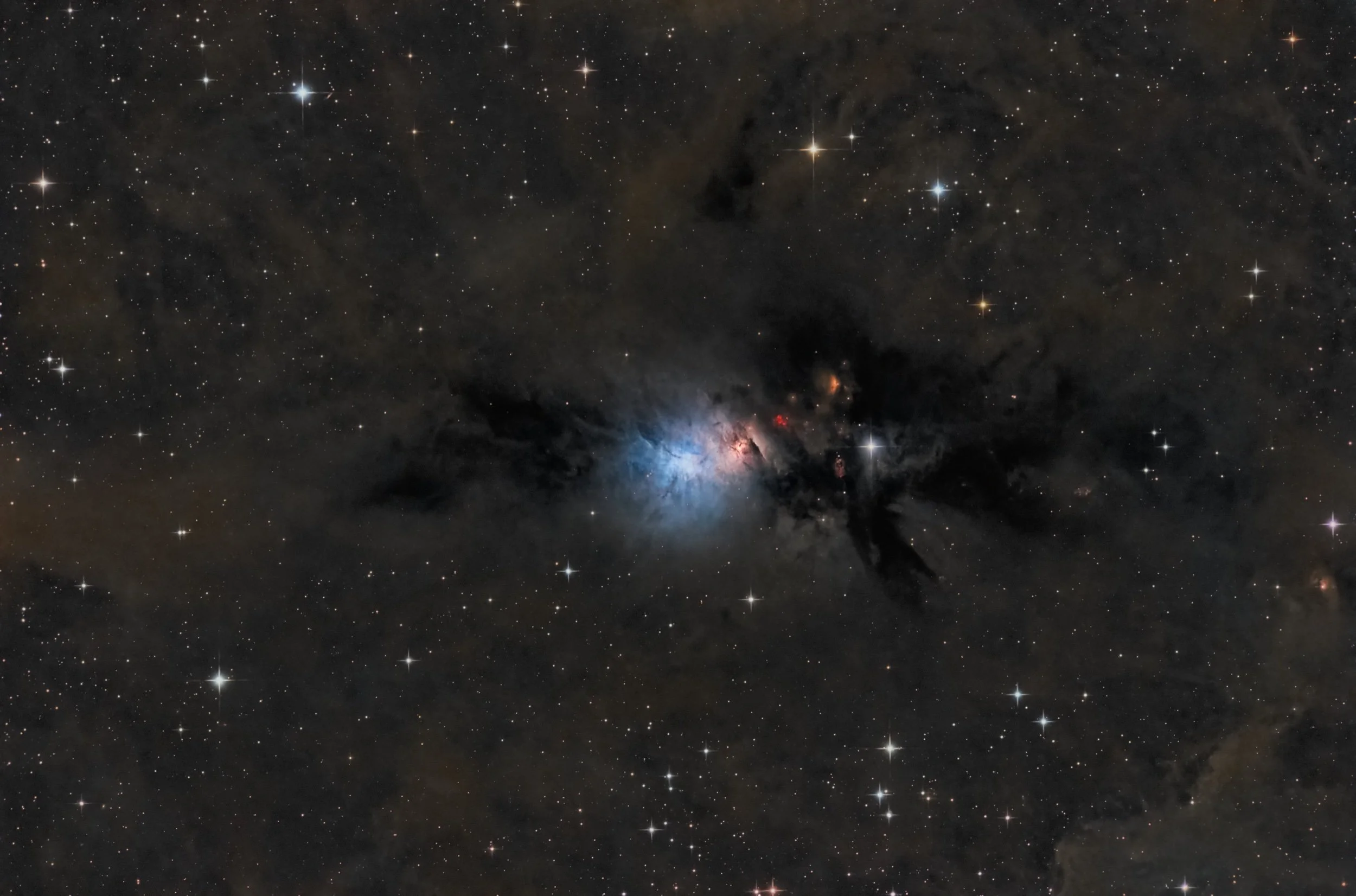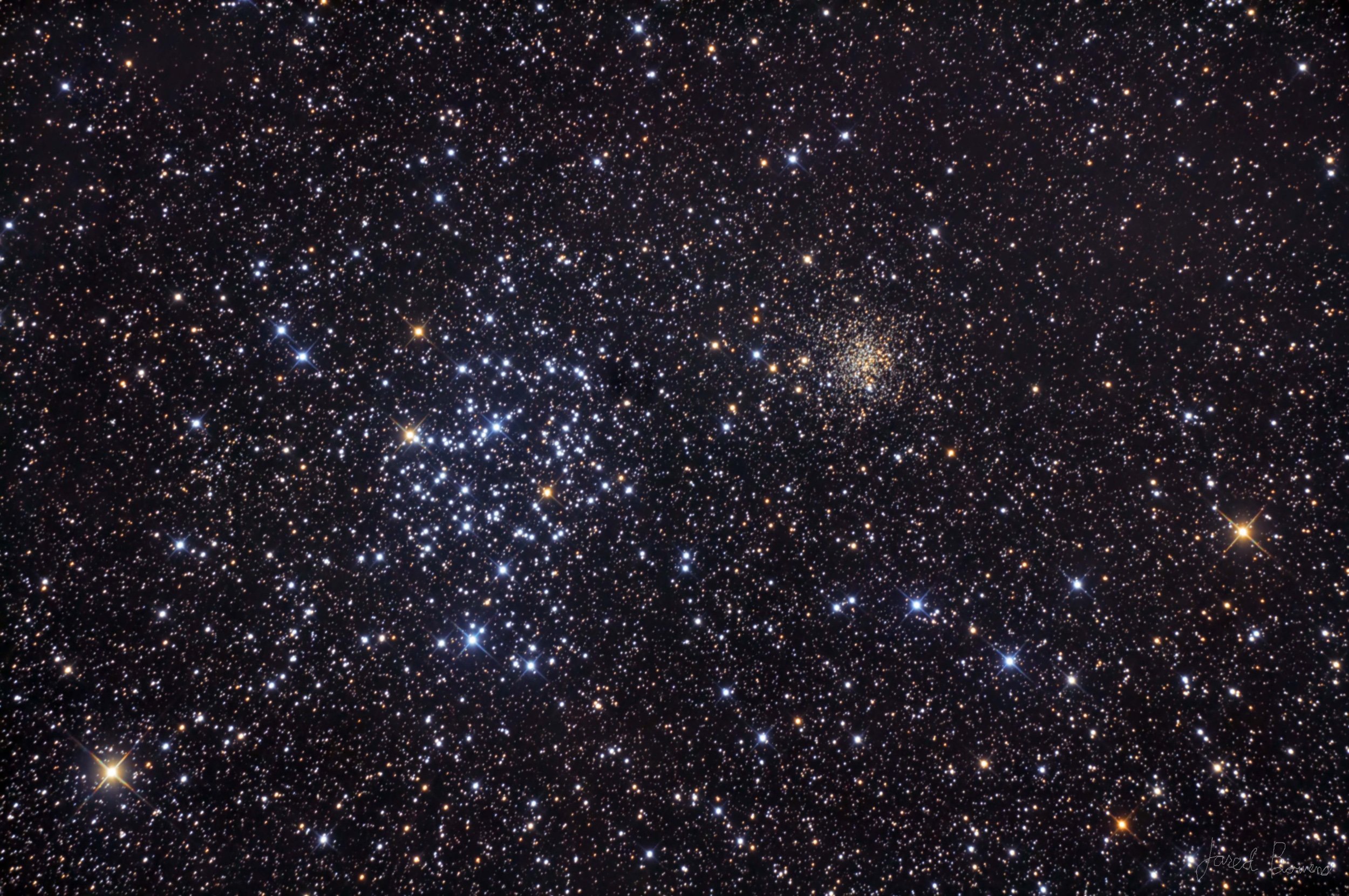
AAPOD2 Image Archives
Christmas Tree Cluster and Cone Nebula
Image Description and Details : Taken with Takahashi Epsilon 160ED, ToupTek 2600KMA, EQ6-R pro, Mgen3, Antlia Edge filters at a Bortle 5 area.
20 x Ha, 20 x Sii, 26 x Oiii à 180 seconds each plus RGB stars.
Copyright: Ava Troost Astrophotography
Big solar prominence
Image Description and Details : Big solar prominence taken with an H-alpha filter and an apochromatic refractor.
Copyright:: Salvo Lauricella
A freeze-frame on the Prawn Nebula & Many More
Image Description and Details : This wide field picture features many celestial jewels, including but not limited to IC 4628, NGC 6268, NGC 6231, & NGC 6244. The main object drawing the astronomer attention is most probably IC 4628, a bright Nebula appearing in the constellation Scorpius and located somewhere 6,000 light years from our solar system. Also dubbed the "prawn nebula", it is believed to be a massive stellar nursery, where new stars are forming. Scientists classify it as an emission nebula because its gas has been energized, by the radiation of nearby stars.
Acquisition details:
Processing : @ae_astrophotography
Data : telescope l
Scope : Takahashi FSQ 106 located in Australia
Filters : Sii, Ha, Oiii which gives the so-called "Hubble Palette"
Total integration time : 15H
Copyright: @ae_astrophotography
NGC 1499 - California Nebula
Image Description and Details : To make this a little different to the usual red images of this target, I used narrowband filters and processed this in the SHO Hubble palette resulting in a colourful rainbow-like image. The OIII signal was however very faint, so I captured extra data with this, 19 hours in all, resulting in 48 hours total integration time.
Date of capture: Jan 13 to Feb 17, 2023
Location of capture: Castilléjar, Spain
Light frames:
Ha: 83 x 600 seconds
OIII 114 x 600 seconds
SII: 74 x 600 seconds
Red: 25 x 180 seconds
Green: 24 x 180 seconds
Blue: 25 x 180 seconds
Total Integration: 48 hours 55 minutes
My equipment and details are:
Telescope: Takahaski FSQ106
Mount: Software Bisque Paramount MX+
Camera: Moravian C3-16000 PRO
Filters: 3nM Chroma Ha, OIII, SII and Red, Blue, Green for the RGB stars
Guiding: Moravian C1-1500 and OAG
Focuser: Moonlite NiteCrawler WR35
Copyright: Copyright: Neil Corke
Comet C/2022 U2 Atlas in Auriga
Image Description and Details : Februar 12th 2023 - time 18.00 u.t.
Location: San Romualdo - Ravenna (Italy)
Tecnosky AG70 on Avalon M1
QSI540ws cooled -20
Autoguide with Celestron OAG and QHY174MM
Astrodon RGB GenII E-series and Narrowband 3nm filters
HA-RGB: Ha 15x5min bin2; R 15x2min, G 15x2min and B 15x2min Bin1
Acquired with: Astroart8
Calibrated with bias, dark and flat
Processed with: Astroart8, Paint Shop Pro2023 e plug-in vari.
Copyright: Cristina Cellini
NGC-6188 Chaos & Hope
NGC 6188 is a dazzling emission nebula located in the southern constellation of Ara, about 4,000 light-years away from Earth. This celestial object is a site of active star formation, boasting a cluster of hot, massive stars that illuminate the surrounding gas and dust with their intense radiation.
M95-M96
Image Description and Details : The M96 group, also called the Leo I group, is a collection of galaxies in the constellation Leo. The group contains between 8 and 24 galaxies, including three Messier objects. It is one of the many clusters in the Virgo supercluster.
M96 is the ‘dominant’ galaxy in the group, i.e. the most massive. M95 and M96 are both barred spiral galaxies, of comparable dimensions and a little smaller than our Milky Way (93 000 AL for M96 and 73 000 for M95).
At the top right is the elliptical galaxy M 105 from the bottom, then Ngc 3384 and then Ngc 3389, the highest in the image.
We can also see a beautiful spiral galaxy (seen – by contrast – from the edge) camouflaged in one of the spiral arms of M96.
Other more distant galaxies can be detected in the picture.
Photo taken in Normandy (France) . 7H 15 in L;R,G,B
Set up: Newton skyvision 250 900 f/d 3.6 on Skywatcher mount. Camera ZWO Asi 6200 MM.
Processing APP-Pixinsight-Photoshop
Copyright: Francis Bozon
Abell 39
Image Description and Details :
Abell 39 planetary nebula made from Tona ( Bareclona ) bortle 5 sky with an Orion Optics VX8 200mm f900mm f4.5 reflector and Zwo 1600mm pro camera on skywatcher mount Eq6- r pro. For guidance, the evoguide 50 f230 with zwo178 mm camera has been used. There are a total of 65 * 300s in OIII filter on February 3 and 65 * 60s RGB to each channel on February 12, all shots acquired with NINA 2.0 and processed with Pixinsight 1.8.9-
Copyright: Jordi Compte
NGC 4038/4039 - Viennese waltz in space
Image Description and Details :
For me as an Austrian these are clearly 2 galaxies dancing Viennese Waltz
Astrophysicists consider NGC 4038 / NGC 4039 as 2 interacting galaxies
at a distance of about 75 million light years in the constellation Corvus.
This pair of galaxies is also called Antennae galaxies, named for the long tails of gas and dust they eject.
IAS 10" Newton f/4.5 / QHY268M65
L 65 / R 27 / G 29 / B 26 x 120s (4h54min)
Remote IAS Observatory Hakos, Namibia
Copyright: Herbert Walter
Conjunction Jupiter & Venus
Image Description and Details : Conjunction between Jupiter and Venus over Bougarnin mountain at Tunis
A panorama of 12 photos take it at 18h45 (Tunis Time) from 18/02 to 01/03 with nikon D850 and Sigma 105mm
Copyright: Makrem Larnaout
Messier 106 and surroundings
Image Description and Details : Messier 106 (also known as M106 or NGC 4258) is a spiral galaxy located in the constellation Canes Venatici, lies at a distance of 23.7 million light years from Earth and has an apparent magnitude of 9,1.
At its heart, as in most spiral galaxies, is a supermassive black hole, but this one is particularly active. Unlike the black hole at the centre of the Milky Way, which pulls in wisps of gas only occasionally, Messier 106’s black hole is actively gobbling up material. As the gas spirals towards the black hole, it heats up and emits powerful radiation. Part of the emission from the centre of Messier 106 is produced by a process that is somewhat similar to that in a laser – although here the process produces bright microwave radiation.
The galaxy has another startling feature; i.e., instead of two spiral arms, it appears to have four. Unlike the normal arms, these two extra arms are made up of hot gas rather than stars, and their origin remained unexplained until recently. Astronomers think that these, like the microwave emission from the galactic centre, are caused by the black hole at Messier 106’s heart, and so are a totally different phenomenon from the galaxy’s normal, star-filled arms.
Messier 106 may have a companion galaxy, the spiral galaxy NGC 4217 (top left in my picture, along with the 3 bright stars). NGC 4217 is about 80,000 light years across and appears almost perfectly edge on.
Konus 200/1000 @960mm, f/4.8
Qhy168c @-20 °C
Sky-Watcher Eq6r Pro mount
SvBony CLS filter 222x180"
Optolong L_Ultimate filter 101x300"
N.I.N.A., APP, PixInsight, PS
Copyright: Massimo Di Fusco
The Eye of Horus - NGC-1097
Image Description and Details : NGC1097 is a splendid barred spiral galaxy, about 45 million light years away and located in the southern constellation of Fornax. It is cataloged as a Seyfert galaxy and at its center hosts a supermassive black hole that is devouring a few billion tons of matter every second.
The object is really interesting to photograph because it has many molecular hydrogen clouds (star formation zones), some of which are positioned in a circular shape right around the galactic center and spiraling around the black hole. The spiral shape is deformed due to the gravitational interaction with some neighboring galaxies: NGC1097A (embedded “perspectively” in one of the two arms) and NGC1097B (farther from the center).
Copyright: Massimo Di Fusco
APOLLO MISSIONS
Image Description and Details : The Moon has always fascinated humanity, for its beauty, size and phases.
In 1969, the man managed to walk on it and return safely, overcoming all the challenges of the time.
After this unprecedented landing, there were five more successful missions of manned landings, ending the Apollo Mission in 1972 with the landing of Apollo 17.
Today man is repairing himself to return to the Moon and continue his exploration of this precious satellite of ours.
This photo depicts the regions and dates of the six manned moon landings, symbolizing the golden period of lunar exploration, signaling future lunar explorations.
Technical Specification: Explore Scientific APO 80 mm Telescope; Baader IR685nm filter; ZWO ASI 290MM camera; AZEQ5 Sky-Watcher mount; Programs: FireCapture 2.6.08, AutoSakkert!3, Image Composite Editor, AstroSurface, RegiStax6, Affinitty Photo and IrfanView 64. Photo composed by mosaic of 02 panels.
Copyright: Natan Fontes
The angel nebula
Image Description and Details : NGC 2170 is a dusty reflection nebula and stellar nursery that formed about 8 million years ago, located at the edge of the giant star-forming molecular cloud Monoceros R2, some 2,700 light-years away. the constellation of Monoceros. The bluish areas are reflection nebulae, so named because they reflect light from nearby hot stars. The red areas are emission nebulae and glow because ultraviolet light from nearby stars excites hydrogen and other gas atoms in the nebula, which then emit their own light in specific colors. What looks a bit like black ink spread across the image are dark nebulae, and are only visible because of the light they block.
TSA120 and asi 2600mm
300 x 180s with L filter
45 x 180s on each rgb channel
Total: 21h45
Copyright: Julien FABRE
NGC 2029
Image Description and Details : This is a Narrowband image of NGC 2029, which is an area of emission nebulae in the LMC. This is a modified Sulphur II, Hydrogen Alpha, Oxygen III (SHO) image. The SHO combination, conventionally called the Hubble Palette, maps SII to Red, Ha to Green and OIII to Blue. It does however produce quite garish colours and pink stars.The mix is therefore often modified to give a more aesthetically pleasing image, but one where the abundance of the chemical species is still well mapped in a colour image. After some experimentation I went with:
Red: 50% SII + 50% Ha
Green: 20% Ha + 70% OIII
Blue: 100% OIII
I removed the stars with StarXTerminator, before processing the image. Previously I had removed the natural colour (RGB) stars in processing the LRGB image and I was able to use Pixel Math to add them back to this finished image, to give a much more pleasing star field.
The amazing tendrils of gas come through well in this version and I hope you like it, both for its scientific value in mapping the presence of Hydrogen, Oxygen and Sulphur in this region of the sky, but also for its aesthetics.
OTA: C11 EdgeHD
Camera: SBIG 16803
Mount: Paramount MEII
Filters: Astronomik 50mm RGB, Ha, OIII & SII
Exposures:
Ha: 17 x 1800 secs
OIII: 17 x 1800 secs
SII: 16 x 1800 secs
Red: 25 x 600 secs
Green: 24 x 600 secs
Blue: 24 x 600 secs
Total SHO integration: 25 hrs
Total RGB integration (stars): 12.2 hrs
Bias: 35
Darks: 35
Flats: 20
Copyright: Niall MacNeill
Solar prominence
Image Description and Details : My first solar image in 2023! A beautiful prominence was visible under difficult circumstances. I put the Earth into the image for a size comparison.
Equipment:
- Lichtenknecker 90/1350 refractor
- Coronado Solarmax 90 I (Ha-filter)
- ASI290MM
Image acquisition:
- 10000 frames capured at 170 fps
- Gain 0, 3.2 ms exposure time
Stacking and image processing:
- Stacking of the best 750 images in Autostakkert3
- Sharpening in Registax6
- Adding false colour in Photoshop, contrast, sharpness and brightness
Copyright: (c) Robert Schumann
M35 Clusters
Image Description and Details : Here’s a capture of two star clusters. The large open cluster on the left is M-35 is a relatively close open cluster of stars in the west of Gemini.
The smaller further away cluster is NGC-2158.
Taken with a 8 inch f3.9 orion newtonian astrograph, Canon 60d unmodified, AVX mount, orion starshoot autoguider 60mm guide scope
3 hours 3-minutes subs ISO-1250
Stacked with Deep sky stacker, Processed with pixlinsight: dynamic background, histrogram transformation, Noisexterminator, added luminous mask for experimental transform, added luminous mask for curve saturations. added star mask used morphologies transformations. Photoshop: selective color, contrast, levels adjustments.
Copyright: Jared Bowens
The Statue of Liberty Nebula - NGC 3576
Image Description and Details : Telescope: Sky-Watcher 250/1200 Black Diamond Reflector
Imaging Camera: ZWO ASI294MM Pro @ -10C, 121 Gain, Bin 2
Guide Camera: ZWO ASI290MM Mini + ZWO OAG
Mount: Sky-Watcher NEQ6 (Belt Mod + Hypertuned by Astronomy Academy Perth)
Filters: Astronomik 6nm Ha/Sii/Oiii + RGB
Acquisition details:
82x300s Ha
69x300s Oiii
67x300s Sii
40x30s RGB
Copyright: Daniel Faull

